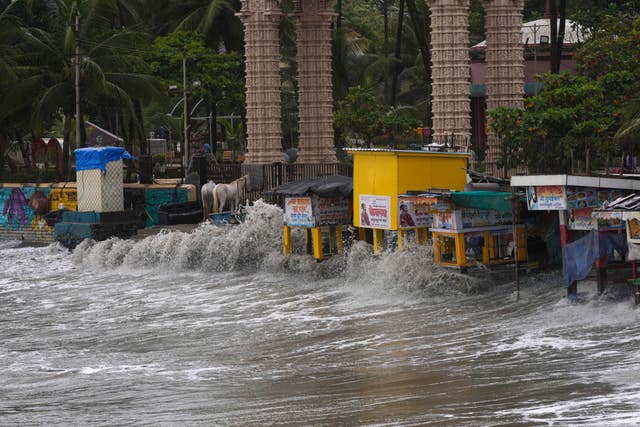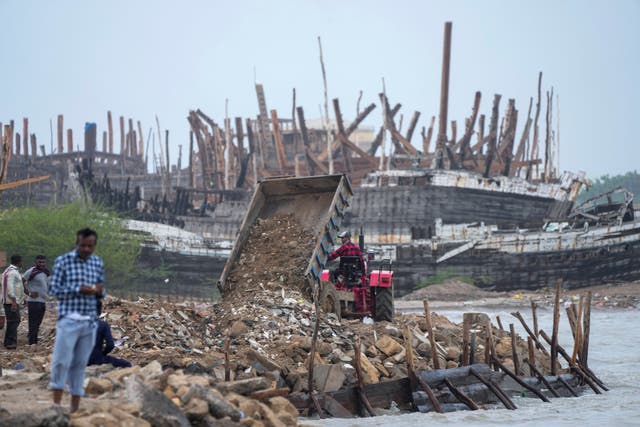
The coastal regions of India and Pakistan were on high alert on Wednesday, with tens of thousands of people being evacuated from their homes a day before Cyclone Biparjoy was expected to make landfall.
The India Meteorological Department said the cyclone is now packing maximum sustained winds of up to 90mph (145kph) and is projected to make landfall near Jakhau port in the Kutch district of Gujarat state on Thursday.
Residents living within three miles (5km) of the coast in Gujarat were evacuated, and those living within 6.2 miles (10km) may also have to move out, officials have said.
Cyclone Warning for Saurashtra & Kutch Coasts: RED MESSAGE. VSCS BIPARJOY at 0830 IST of today over NE Arabian Sea near lat 21.9N & long 66.3E,about 280km WSW of Jakhau Port (Gujarat) and 290km WSW of Devbhumi Dwarka. To cross near Jakhau Port by evening of 15th June as VSCS@WMO pic.twitter.com/j7bMLeen1c
— India Meteorological Department (@Indiametdept) June 14, 2023
Four people have died so far in incidents related to the cyclone, including three boys who drowned off Mumbai’s coast and a woman who was killed in an accident caused by strong winds in Gujarat.
A search is continuing to find one more person who drowned in the sea off Mumbai.
Experts say climate change is leading to an increase in cyclones in the Arabian Sea region, making preparations for natural disasters all the more urgent.
At a relief camp for displaced people in the Pakistani village of Gharo in Sindh province, wage labourer Allah Noor, 59, said soldiers came and evacuated them amid a strong windstorm.
In Kutch, where the cyclone is expected to hit land, 57-year-old boat owner and businessman Adam Karim Dhobi said it was the worst storm he has seen since 1998.
“We have parked our boats in safe places,” he said. “We are praying to God that this cyclone doesn’t cause too much damage here.”
Visuals of NDRF deployment at Mandvi Beach in Gujarat's Kutch ahead of the expected landfall of #CycloneBiparjoy on June 15. pic.twitter.com/Siq1VWbzXD
— Press Trust of India (@PTI_News) June 14, 2023
The Press Trust of India news agency said nearly 40,000 people have been moved to relief camps in Gujarat.
Nikhil Mudholkar, from the National Disaster Response Force who is overseeing relief operations in Devbhoomi Dwarka district along Gujarat’s coast, said they are fully prepared and are now in waiting mode.
“We have deployed 23 teams and have moved everyone living near the coast to safer grounds,” he said. “Wind speeds have picked up now and rains have started too.”
In Pakistan, despite strong winds and rain, authorities said all people from vulnerable areas have been moved to safer places in the southern districts, including Thatta, Keti Bandar, Sajawal and Badin – regions that only last summer were affected by devastating floods which displaced thousands.
For many there, it is the second displacement in less than a year.
 Waves hit stalls on the beach during high tide on the Arabian Sea coast in Mumbai, India (Rajanish Kakade/AP)
Waves hit stalls on the beach during high tide on the Arabian Sea coast in Mumbai, India (Rajanish Kakade/AP)
People packed up as many of their belongings they could into their cars and left – either on their own or under troop escort – heading to relief camps set up inside government buildings and schools.
At the Gharo relief camp, 80-year-old Bayan Bibi said no medicine is available for the sick.
On Tuesday, Pakistani Prime Minister Shahbaz Sharif ordered evacuations from risk areas and asked local authorities to arrange food, shelter and medical facilities for the displaced.
Pakistan’s climate minister, Sherry Rehman, urged people not to panic but work with the authorities, promising they would be taken to safer places.
The cyclone has “extensive damaging potential” and is likely to affect Kutch, Devbhumi Dwarka and Jamnagar districts the most, India’s IMD has said.
Fishing activities have been suspended in both countries until June 16.
All ports in the region, including the major ports of Kandla and Mundra, have been shut, and dozens of trains and flights have been diverted or cancelled.
 A tractor is used to make a seawater defence wall on the Arabian Sea coast at Mandvi in Kutch district of Gujarat state (Ajit Solanki/AP)
A tractor is used to make a seawater defence wall on the Arabian Sea coast at Mandvi in Kutch district of Gujarat state (Ajit Solanki/AP)
Also on Tuesday, India’s home minister, Amit Shah, held an emergency meeting with senior officials to review preparedness and announced a budget of 972 million US dollars (£773 million) for disaster management.
A recent study shows that the Arabian Sea has warmed up by almost 1.2C since March this year, making conditions favourable for severe cyclones, he said.
“The oceans have become warmer already on account of climate change,” Raghu Murtugudde, an Earth system scientist at the University of Maryland, said.
Another study, in 2021, found that the frequency, duration and intensity of cyclones in the Arabian Sea increased significantly between 1982 and 2019, he said.
Cyclone Tauktae in 2021 was the last severe cyclone that made landfall in the same region. It claimed 174 lives, a relatively low figure thanks to extensive preparations ahead of the cyclone.
In 1998, a cyclone that hit Gujarat state claimed more than 1,000 lives and caused excessive damage.
A cyclone that hit Sindh province and the city of Karachi in 1965 killed more than 10,000 people.


Comments: Our rules
We want our comments to be a lively and valuable part of our community - a place where readers can debate and engage with the most important local issues. The ability to comment on our stories is a privilege, not a right, however, and that privilege may be withdrawn if it is abused or misused.
Please report any comments that break our rules.
Read the rules here